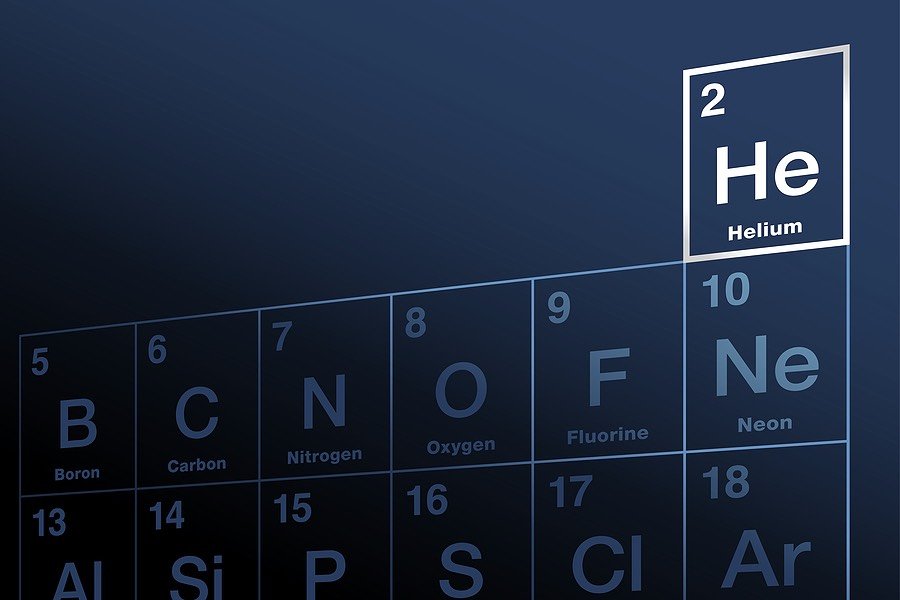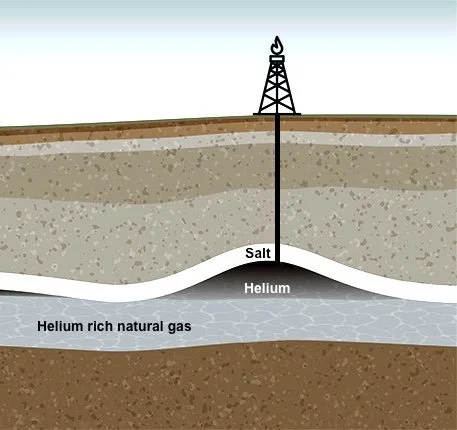HELIUM
The second most abundant element in the universe and a finite dwindling supply on earth
Noble Gas
Helium is completely inert and will not react with any other element. It is colorless, tasteless, and odorless, non toxic and non combustible with extremely low solubility. These characteristics make it highly valuable for creating pure, non-reactive environments for manufacturing and research.
Cryogenic Properties
Helium has the lowest boiling point of any element. It is the last element to become liquified and the coldest substance on earth in liquid form. It is the most important element where temperatures approaching absolute zero are required and for studies in super-cold physics.
Cryogenic Separation
Helium is most commonly extracted by fractional distillation from natural gas.
Gases are separated by exposing the crude helium to increasingly lower temperatures. Helium has the lowest boiling point of all elements, therefore the other gases become liquified first and can be separated from the helium.
In the final purification phase, activated charcoal is used to achieve pure Grade A helium.
Medical
Helium is combined with oxygen for the treatment of asthma, emphysema, and other respiratory problems - the combined gases penetrate the lungs much quicker than a stand alone oxygen treatment.
Welding
Helium works well as a shielding gas because it is non-reactive and allows for a consistent weld at a higher heat transfer.
Fiber Optics
The cables are manufactured inside of a pure helium atmosphere to avoid imperfections, such as air bubbles getting trapped inside the cable.
Pricing
Industry Usage
Future Demand
Drivers of future growth are the increasing consumption of helium in the electronics and semiconductor industry and quantum computing, as well as the growing usage in the healthcare and space industries.
The rise in consumption from the Asia Pacific Region (APR) reflects the dynamics of economic growth globally. The forecast for helium consumption in the APR over the next twenty years is to reach 5 Bcf per annum.
Exploration
Most of the new helium supply continues to be as a by-product of natural gas production. If the world is to achieve carbon targets over the next few decades then natural gas production is forecast to decrease significantly.
There is a need for helium-focused producers to emerge in the coming years in order to replace existing helium supplies from hydro-carbon sources. The trend is towards helium as the primary economic driver and not as a by product of methane extraction.
Importance
Helium has qualities that make it irreplaceable. It is incredibly light, the smallest molecule, frictionless at specific temperatures , persists as a liquid at near absolute zero, and is completely non-reactive. It is ideal for cooling, leak detection and critical to some medical applications and manufacturing in controlled environments.
MRI Equipment
MRI machines uses an extremely powerful magnet to produce detailed images of internal body structures. The high-powered magnet has to be cooled down in order to operate.
Fiber Optics
The cables are manufactured inside of a pure helium atmosphere to avoid imperfections, such as air bubbles getting trapped inside the cable.
Sources
Ideal Conditions
The highest helium concentrations are found where the following conditions exist:
Basement granite rock is rich in uranium and thorium.
A layer of fractured sedimentary rock provides escape paths for the helium.
An impermeable layer of halite or anhydrite rock seals the layer of porous sedimentary rock.
When these conditions exist there is a good probability helium might accumulate in the porous sedimentary rock layer.
The largest reserve of crude helium was owned and managed by the US Bureau of Land Management, located in Amarillo, Texas. This reserve was set up in 1960 as a strategic reserve.
IN 1996 the Helium Privatization Act was passed to sell off the reserve and pay off the reserve and pay off the plant’s debts. The effect was to suppress the price of Helium for more than a decade.
In 2019 the BLM held the last crude helium auction with the Federal Reserve reaching its minimum target level of 3 BCF. The remaining stockpile is mandated to be completely distributed by the latter half of 2022.
The size and depletion of the Federal Reserve has removed a sizeable portion of helium from the global market. This reduction in supply combined with increasing demand in high tech fields has resulted in an upward trend in price for helium since 2016.
Scarcity
There is no substitute for helium. It can not be artificially produced or synthesized. Reactive decay takes billions of years to produce the helium atoms found on earth. Although abundant in space it is uneconomical to harvest helium than from the earth’s crust.
Where is it found
Helium is a by-product of fusion reactions occurring inside stars. As a result it is abundant in space. On earth helium is produced underground through the slow and steady radioactive decay of certain elements such as uranium and thorium. Another potential source of helium within the earth is primordial; the helium atoms were captured as part of the original formation of the planet.
Production by Country
Global reserves of helium are generally located in the United States, Russia, Qatar, Algeria, and Iran. More recent discoveries have occurred in Canada, Southern Africa, and Australia.
The United States has the world’s largest proven reserves and historically was the world’s major producer, 75% in 2010. However, the depletion of the BLM Strategic Reserve together with new supply from Qatar has lessened its role. The US share of helium production is forecast to decrease below 20% by 2030.
US BLM
How Helium is Produced
Helium is typically found in combination with other gases such as methane and nitrogen. These gases exist underground in basement rock that is drilled and then fractured and faulted to provide escape routes. Once the gases are extracted they are separated and processed further.
Pressure Swing Absorption (PSA)
The helium is separated from a mix of gases based on its affinity for an absorbent material - such as zeolites or activated carbon.
The absorbent is used as a trap, absorbing the helium gas at high pressure. Ideally, only the helium is absorbed, while all other gases, in the mixture pass through the absorbent material.
The process the swings to low pressure to release the helium which can then be captured.
This process is less efficient than cryogenic separation in terms of both energy use and helium lost during separation.
Production Summary
Identify a helium reserve
Drill development wells
Determine the gas flow rate
Measure reservoir pressure
Sample analysis to measure helium content
On site purification and cryogenic liquefaction of the helium
Delivery to storage facilities using vacuum insulated tankers
Applications
The choice between helium and substitute gases may be determined by economics, market conditions, availability, safety, and legislation. However some applications rely critically on helium’s unique properties, and there is no alternative. These applications typically rely on the extremely low boiling point of liquid helium to achieve a desired result. Examples include purging of rocket ship fuel tanks, superconductivity required in MRI equipment and scientific research where temperatures down to millikelvins above absolute zero are required.
Air Bags
The molecular size of helium and its ability to diffuse quickly allows the airbag to inflate nearly instantaneously upon impact.
The Market for Helium
Unlike commodities such as oil and natural gas that have a central benchmark price (WTI, Henry Hub), wholesale pricing for helium is negotiated through private contracts among a few large suppliers.
There is no single spot price for helium and no independent authority that tracks supply and demand.
However the trend is clear, prices are increasing. Traditional sources in the United States (BLM and the Hugoton Gas Field) are in decline. Sources outside the US are generally in politically unstable regions (Algeria, Russia, Iran and to some extent Qatar) that have consistently demonstrated supply disruptions.
Demand for Helium
Global Consumption
Helium consumption is correlated to the global structure of economic development with demand coming from technologically advanced countries. The United States has seen a decline from 60% of total global consumption in 2001 to less than 40% in 2021.
Hard Drives
Helium filled hard drives provides near zero resistance to spinning discs, allowing for a higher number of discs to be incorporated in the same space making the drive lighter, faster and cooler than traditional air filled drives.
Scuba
Tanks are filled with an Artificial atmosphere of 80% helium and 20% oxygen.
Nuclear Reactors
Chemical inertness, compatibility with other reactor materials, high thermal conductivity and specific heat properties of helium enable high thermo-dynamic efficiencies.
Market Size
In 2021 the global market for bulk liquid helium was estimated at $2.8bn.
At a CAGR (compounf annual growth rate) of 5% the market is expected to reach a total valuation of $4.6bn by 2032.
In comparison the total size of the industrial gas market was $93bn in 2021 and expected to reach $127bn by 2027.
Year Price Note
2016 $ 100/mcf Above $ 100 for the first time
2018. $ 280/mcf Final BLM auction price
2021. $ 600/mcf Typical contract price
2022 $ 1000/mcf Spot price for some retail buyers
2023. $ 1200/mcf Spot price for some retail buyers
Market Segmentation
Phase
Liquid Helium, Gaseous Helium
Application
Breathing Mixes, Cryogenics, Leak Detection, Pressurizing and Purging, Welding, Controlled Atmosphere.
Global demand for helium is currently estimated to be 6 Bcf pa. At a growth rate of 3% pa global demand is forecast to reach 8 Bcf pa by 2032.
Use
Aerospace and Aircraft, Electronics and Semiconductors, Nuclear Power, Healthcare, Welding, and Metal Fabrication.
Supply Constraints
Worldwide, helium is available from just a few sources. Five fields supply 80% of the world's helium. Disruptions at any of these fields generally has a notable impact on global helium supply.
Geopolitical tension in the Emirates in 2017 and Qatar's isolation resulted in disruption to 30% of the world's supply. More recently incidents at Russia's Amur Helium plant and conflict with Ukraine has highlighted the risk of foreign sources.
Helium is listed on the critical materials list of major economies such as the United States, the European Union, and China with the risk of supply shortages considered economically significant.
Helium is traded in bulk as a liquid product below its boiling point, close to absolute zero. Helium logistics are complex and require specialist expertise and equipment. The shelf life of the product is measured in weeks; it is a just-in-time product with a fragile supply chain that can easily be disrupted.
Helium's critical importance to industries such as magnetic resonance imaging (MRI) and semiconductor manufacturing means that any supply disruptions have a severe impact on these dependent industries.











